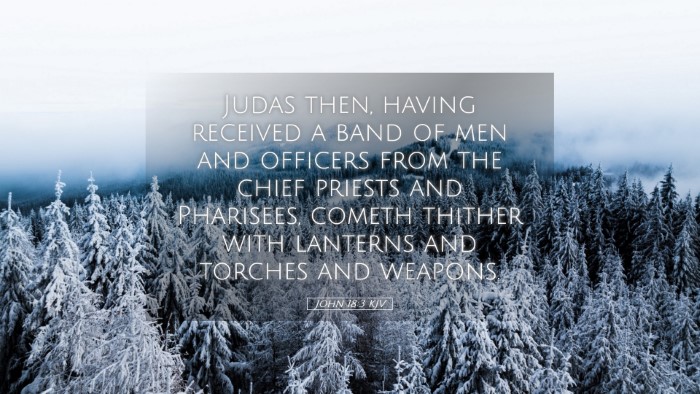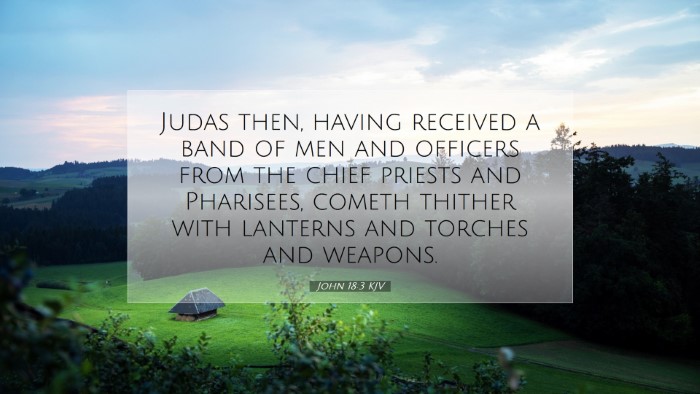Commentary on John 18:3
John 18:3 (KJV): "Judas then, having received a band of men and officers from the chief priests and Pharisees, cometh thither with lanterns and torches and weapons."
Contextual Overview
The events surrounding John 18:3 take place in the culmination of Jesus’ ministry on earth. This moment is pivotal as it leads to His arrest, trial, and eventual crucifixion. Judas Iscariot, one of the twelve disciples, capitalizes on his intimacy with Jesus to betray Him, demonstrating the tragic nature of spiritual treachery.
Insights from Public Domain Commentaries
Matthew Henry's Commentary
Preparation for Betrayal: Matthew Henry emphasizes that Judas's betrayal was premeditated and grave. He notes how Judas “having received a band of men” signifies not only betrayal but an armed detachment that indicates the seriousness with which the religious leaders approached capturing Jesus.
The Role of the Chief Priests: Henry further elucidates the role of the chief priests in this event. Their collaboration with Judas highlights their resolve to eliminate Jesus and reflects their fear of losing religious authority. “They were resolved to do their worst against Christ,” observes Henry.
Albert Barnes' Notes on the Bible
The Characteristics of the Arrest: Albert Barnes discerns the symbolism of the “lanterns and torches.” He interprets these items as reflective of spiritual darkness. “They come with lights to seize the Light of the World,” Barnes notes, illustrating the irony of this moment. The physical tools meant to illuminate were ultimately futile in their pursuit of the truth.
The 'Band of Men': Barnes highlights that the “band” referred to can indicate a Roman cohort or a detachment of soldiers – a significant show of force against a non-violent teacher indicates the fear that Jesus inspired in religious leaders. Barnes suggests that this shows not only their enmity but also their deep-seated prejudice against His influence.
Adam Clarke's Commentary
Judas’ Intent and Actions: Adam Clarke elaborates on Judas’s betrayal as an act of calculated disloyalty. He questions Judas’ motives, suggesting that for a sum of thirty pieces of silver, he forfeits his moral integrity and the fate of his soul. Clarke delivers insightful commentary on the nature of betrayal comparing it to various figures throughout Scripture who similarly turned from their divine commitments.
The Psychological Implications: Clarke also discusses the heaviness of Judas’s guilt. By leading a band of armed men, he becomes a physical representation of betrayal that not only affects him but also those he leads into confrontation with Jesus. This psychological burden of betrayal and subsequent actions resonate throughout the Gospel narrative.
Theological Themes
- Betrayal: This verse offers a deep exploration of betrayal, particularly the implications of betrayal within spiritual contexts. Judas’s actions serve as a sobering reminder of the potential for treachery within places meant for sacred fellowship.
- Darkness vs. Light: The juxtaposition of the light (lanterns and torches) and the one who embodies the Light of the World is central to Christian theology. This highlights the tension between good and evil, faith and doubt.
- Authority and Power: The involvement of the chief priests and Roman soldiers demonstrates the intersection of religious and secular authority in opposition to Christ. This sets the stage for the divine narrative regarding the Kingdom of God versus earthly power.
- Fulfillment of Prophecy: Judas’s betrayal fulfills Old Testament prophecies, reinforcing the sovereignty of God and the divine plan for redemption through Christ’s sacrifice.
Application for Pastors and Theologians
This passage serves as a profound instruction for pastoral care regarding the themes of betrayal and loyalty. It invites examination of one’s own faithfulness to Christ against the backdrop of those who have fallen away. The daring act of bringing armed men to confront Jesus can serve as a parable for both personal and communal sin — the tensions that arise when the faith community stumbles into moral and spiritual compromise.
The commentary also encourages a deeper reflection on the types of “weapons” that the spiritual leaders wield today: are they enforcing policies of exclusion or promoting justice and mercy? The light brought forth in this narrative calls the church to illuminate paths of grace and truth, dispelling darkness in communal and individual lives.
Conclusion
John 18:3 encapsulates a moment of profound betrayal that serves as a critical juncture within the New Testament narrative. The insights from Matthew Henry, Albert Barnes, and Adam Clarke combine to enrich our understanding of the depth of human treachery, the stark contrast of light and darkness, and the implications for both the first-century community and modern readers of Scripture. This commentary encourages rigorous self-examination and communal reflection as we discern our own paths in the ongoing story of faith.


